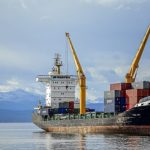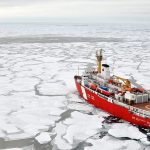Eleven weeks into the voyage, an intrepid crew of four and their captain report that they have passed the halfway mark on their effort to set a new world’s record for circumnavigation of the globe. The team, which set off from Puerto Calero, Lanzarote, in the Canary Islands on December 1, 2021, is seeking to become the first to complete a round the world circumnavigation (via the Capes) on an owner/skippered full displacement motorboat of less than 24 meters.
For this unique trip, the crew is sailing on the Astra, a 78-foot-long vessel built in 1994 which they call “a super-strong expedition vessel that can go anywhere in the world, regardless of the weather.” An ice-classed vessel, she served with Swedish Sea Rescue Service between 1995 and 2016. Because she was built as a rescue vessel, they say that the Astra “is incredibly stable and has no ‘point of vanishing stability’.” They report that she was selected “because of its full displacement characteristics and its safety characteristics.” Powered by a low/medium speed Mitsubishi main engine they calculated that her hull permits a maximum speed of 11.18 knots.
“On sailing from Valparaiso, we had Robinson Crusoe Island 150 miles on our port side and between Alexander Selkirk Island and Easter Island we are 800 miles from civilization! To put this in context, the International Space Station, orbiting 220 miles above the earth is our closest contact to humanity for over 3,000 miles of our crossing of the Pacific until we reach the British island cluster of Pitcairn, Henderson, Ducie, and Oero!,” says Captain Iain Macneil, who is commanding the voyage and CEO of Witherbys, a Scottish publishing company.
The expedition is expected to last a total of five months and the route will be approximately 26,600 miles. Instead of using the Panama and Suez Canal, the trip is taking what they are calling a ‘big seas’ route that is generally only taken by merchant shipping or expeditions heading to the southern continent of Antarctica. By crossing the equator twice, it permits the Astra’s route to be classed as a circumnavigation.
The team has encountered various challenges during the trip, including a major route change. Reacting to weather and current changes en-route to St Helena, the Captain reworked the whole route to reverse direction and head west.
“Although we have faced some obstacles throughout the journey, we have been trying to celebrate whenever we get the chance and managed to have a somewhat normal Christmas and New Year, with minimal decorations, Christmas films, and a turkey dinner with all the trimmings. At sea, it’s important to ensure that, as best as you can, every occasion is acknowledged, otherwise there is a danger of the days all blending in to one.”
According to their most recent update, the most celebrated milestone of the first half of the expedition was when the crew successfully navigated around Cape Horn, a particularly challenging route due to its extreme southern latitude that makes it prone to gale force winds and choppy waters. The Horn marked an important milestone for the team, as the passage is one of the most hazardous shipping routes in the world and, for seafarers, it is regarded as the equivalent of climbing Mount Everest.
The second half of the expedition will see Astra complete its crossing of the Pacific to New Zealand. “Crossing the Pacific in a 24-meter boat is challenging,” says Macneil, “but the 9,000 miles in training and preparation in the five months before we departed has helped to meet the goal of refining and optimizing settings for this extra-long passage.”
Updates on their progress are being posted to the Internet and on the Facebook social media feed.
Source: The Maritime Executive






